18 Stunning Backyard Walkway Ideas for Every Garden
Backyard walkways are not only functional but can also add a touch of elegance to your outdoor space.
Whether you want to create a charming path through your garden, provide easy access to your outdoor seating area, or simply enhance the beauty of your backyard, a walkway can serve all these purposes.
From rustic to modern, the possibilities are endless when it comes to materials and design.
In this article, we’ll explore 18 diverse walkway ideas that cater to all tastes and backyard styles.
18 Stunning Backyard Walkway Ideas
1. Gravel Walkway
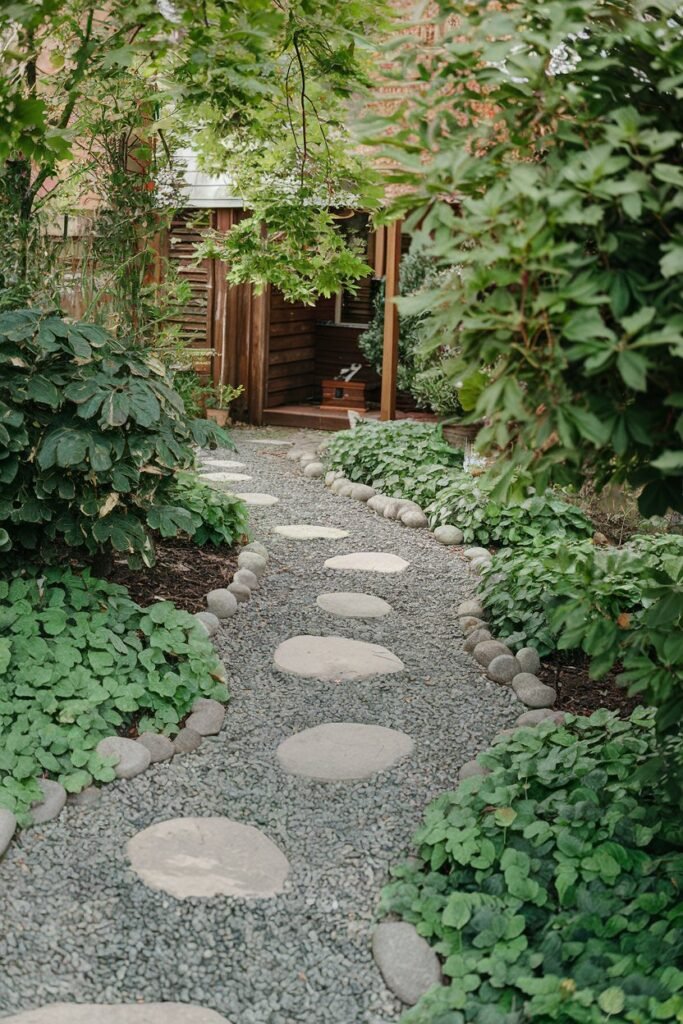
Gravel is a simple yet effective material for creating a natural, rustic walkway in your backyard. It’s affordable, versatile, and allows water to flow through, making it a good choice for gardens with heavy rainfall.
Gravel walkways also work well in informal settings, such as wildflower gardens, herb gardens, or paths leading to a garden shed. To make sure the gravel stays in place, use edging such as metal or stone borders.
You can also add larger stones or stepping stones for a more defined path.
2. Flagstone Path

Flagstone is a popular choice for creating elegant and timeless walkways. The natural stone gives your backyard a sophisticated touch and blends beautifully with various landscape styles.
You can arrange flagstone slabs in a random pattern for a more organic look or create a structured design for a cleaner, more formal pathway. Flagstone is durable and low-maintenance, making it perfect for high-traffic areas.
3. Brick Walkway

Nothing beats the classic charm of a brick walkway. Bricks have a timeless appeal that complements both traditional and modern backyard designs.
The flexibility of brick allows for various laying patterns, such as herringbone, basket weave, or running bond. Whether you choose red, white, or reclaimed bricks, you can easily match the color to your garden’s overall color palette.
Bricks are also durable and weather-resistant, ensuring that your walkway will last for many years.
4. Concrete Slab Walkway
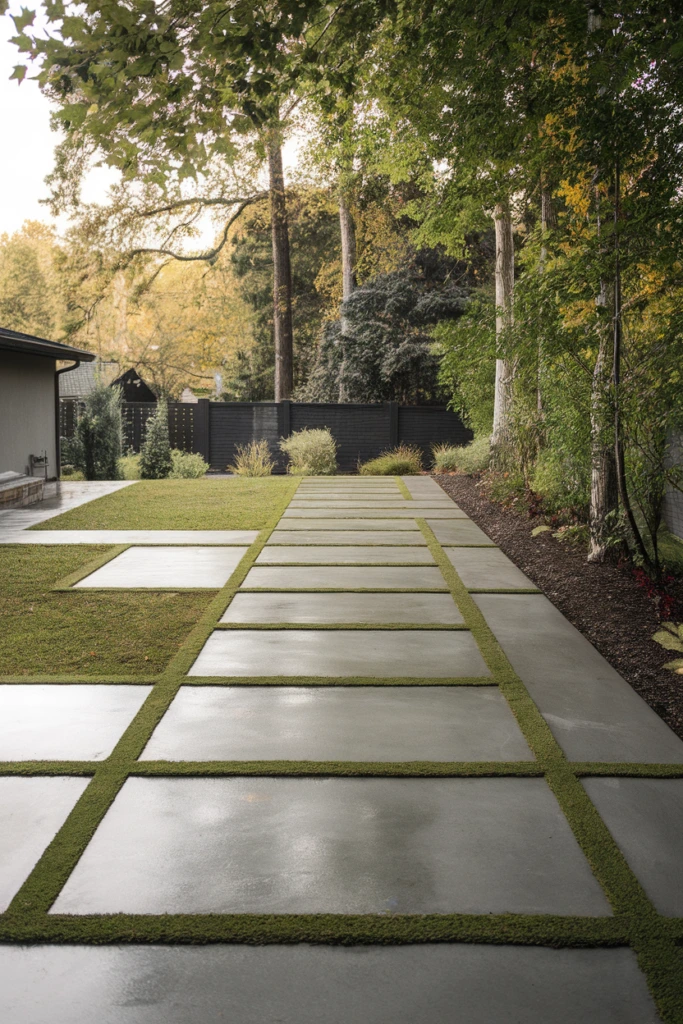
If you’re looking for a modern, sleek look, consider using concrete slabs for your walkway. Concrete is a highly versatile material that can be molded into large, geometric shapes or smaller, more intricate patterns.
You can also stamp the surface of the concrete to mimic the look of stone or brick.
For a minimalist design, opt for large concrete slabs with gaps between them, allowing grass or moss to grow through. This simple yet chic option works well in contemporary or urban backyard designs.
5. Stepping Stones
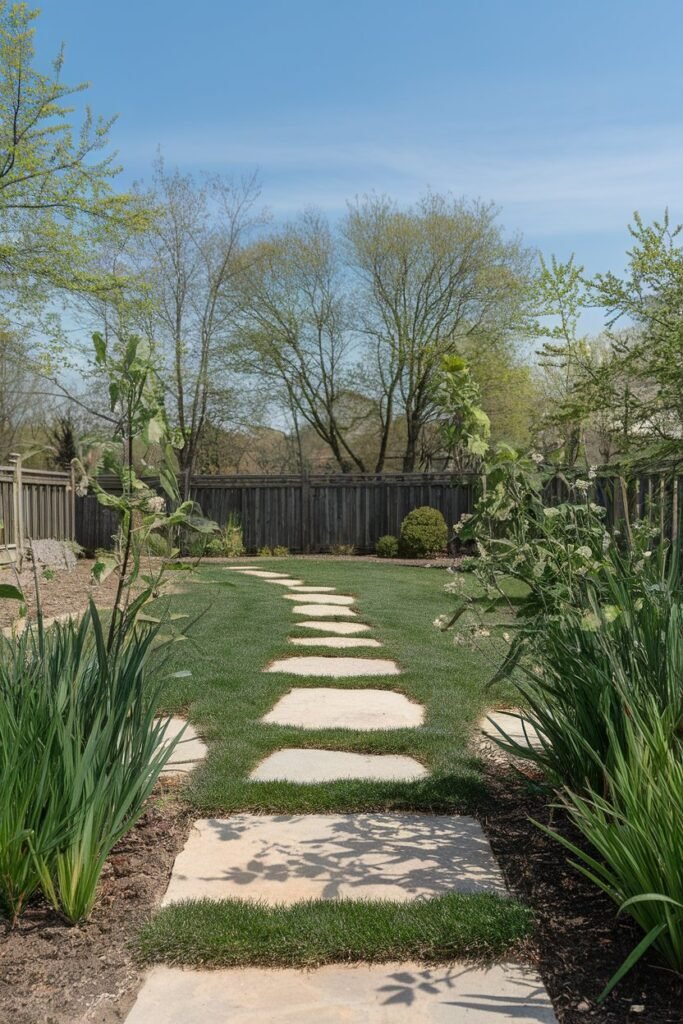
Stepping stones are a fun and easy way to create a natural-looking path in your backyard. These individual stones are spaced out to guide the way, allowing grass or groundcover to grow between them.
Stepping stones can be made of a variety of materials, including stone, concrete, or even wood. This option is ideal for creating a casual, laid-back vibe in your garden and can be customized with different shapes, sizes, and colors.
6. Wooden Planks
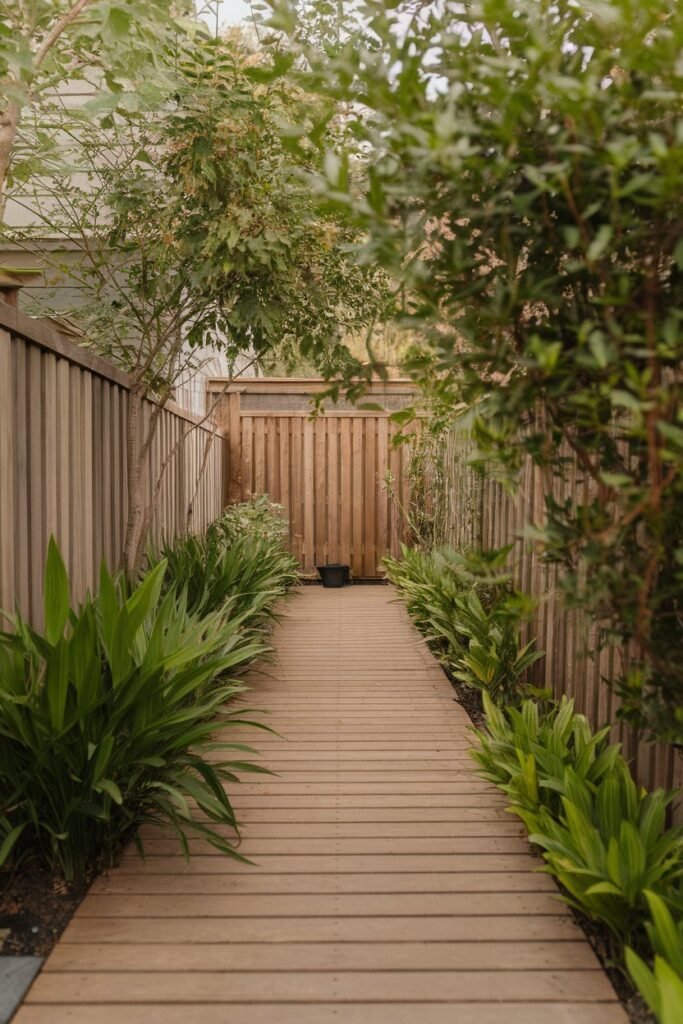
For a rustic or zen-inspired look, wooden planks can make a beautiful addition to your backyard walkway. This material brings an organic feel and can be used in a variety of designs.
Whether you opt for long, narrow planks or short, wide boards, wooden walkways can fit seamlessly into natural surroundings. To prolong the lifespan of the wood, be sure to treat the planks with weather-resistant finishes and sealants.
Wooden planks work particularly well in gardens with a lot of greenery and natural elements.
7. Paver Path

Interlocking pavers are perfect for creating a neat, structured walkway in your backyard. Available in various shapes, colors, and sizes, pavers can be arranged in countless patterns, from classic squares to intricate mosaics.
They are ideal for both formal and casual gardens and offer a high level of durability.
Additionally, pavers can be laid on a gravel base, allowing water to drain through, which helps prevent puddling.
8. Mulch Walkway
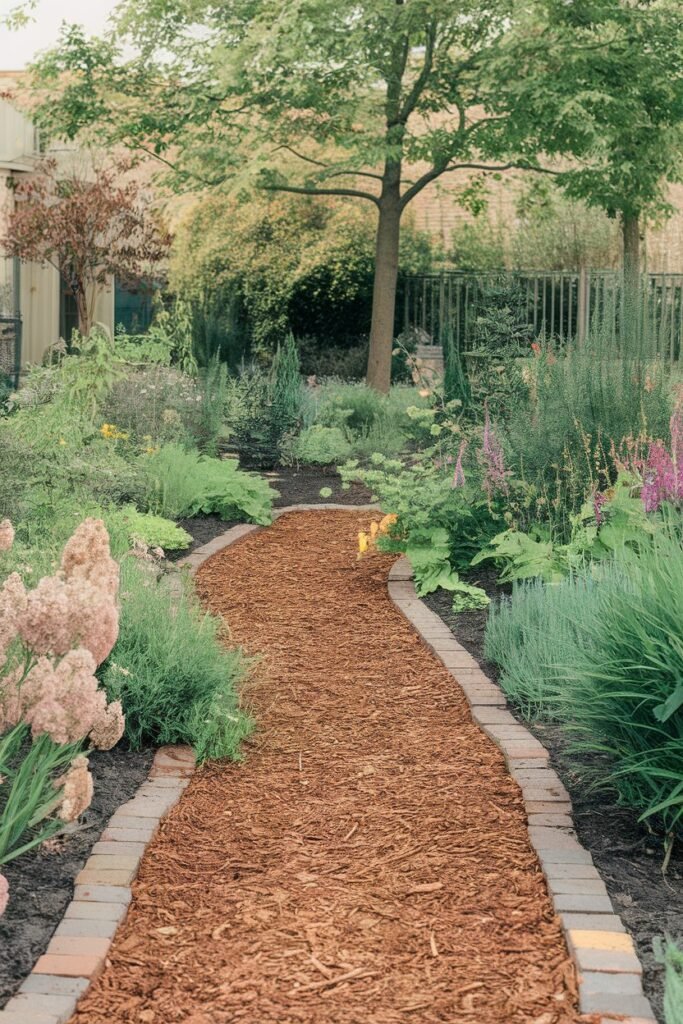
If you’re looking for an affordable, low-maintenance walkway option, mulch is an excellent choice. Mulch walkways provide a soft, natural feel and are perfect for gardens with a lot of flowers, shrubs, or trees.
They help retain moisture in the soil, control weeds, and improve the overall health of your plants.
For a tidy appearance, you can line the edges of the mulch path with bricks, stones, or small logs to define the space.
9. River Rock Path
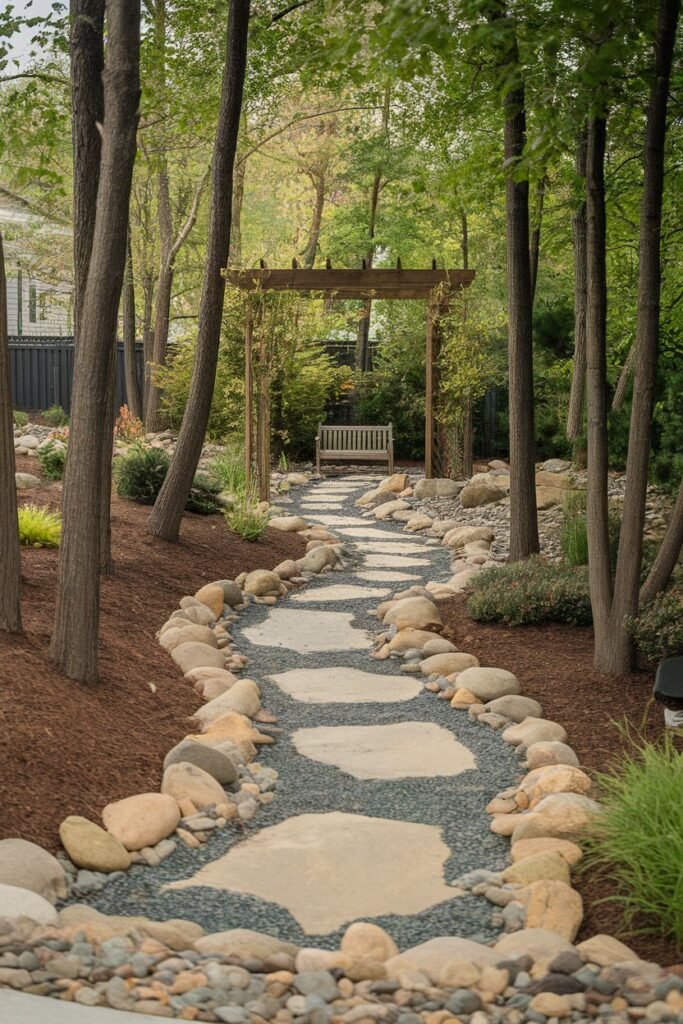
River rocks add a natural, earthy touch to your backyard and are great for creating a pathway that blends seamlessly with the surrounding landscape.
Smooth, round stones work particularly well for a dry riverbed effect, and they’re perfect for creating a low-maintenance, water-permeable surface.
You can also mix river rocks with larger stones or gravel for added texture. This option is perfect for creating winding paths that lead through a forested or woodland garden.
10. Wood Chips
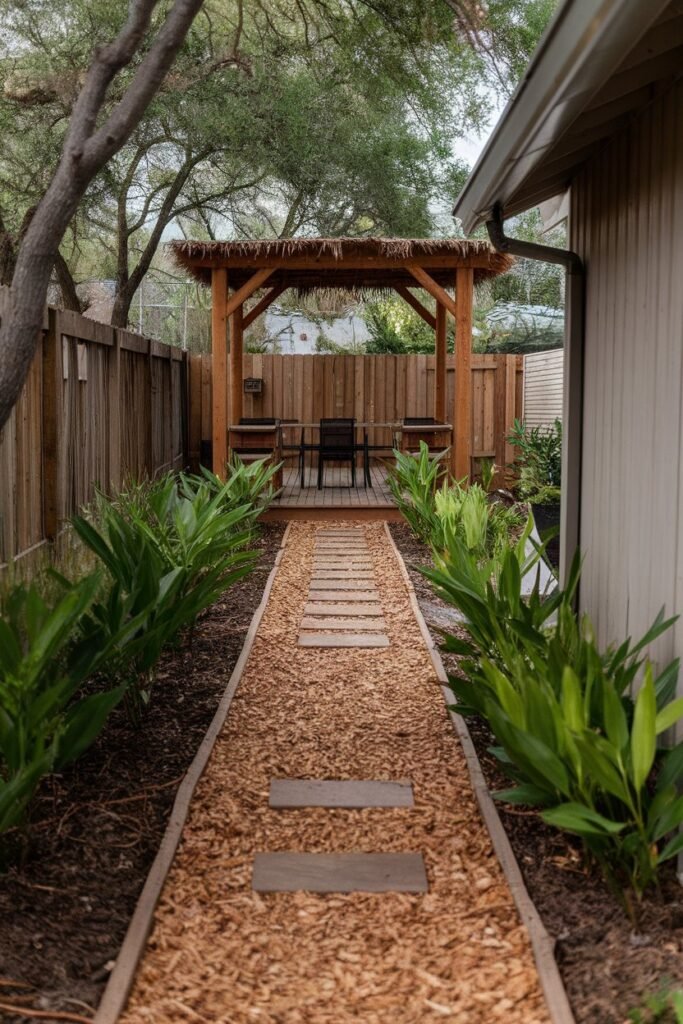
Wood chips are a casual and eco-friendly way to create a walkway in your backyard. This option is ideal for informal settings like vegetable gardens, woodland gardens, or areas where you want a more rustic vibe.
Wood chips are soft underfoot, making them comfortable to walk on, and they provide excellent moisture retention for surrounding plants.
However, you’ll need to replenish them periodically to keep the walkway looking fresh.
11. Cobblestone Path

For a touch of old-world charm, consider using cobblestones to create a traditional-style walkway.
Cobblestones can be arranged in a variety of patterns, such as a running bond or herringbone, to create a classic European-inspired path. They are highly durable, weather-resistant, and ideal for creating a path that will stand the test of time.
A cobblestone walkway pairs beautifully with cottage-style gardens or those with a vintage aesthetic.
12. Mosaic Walkway

If you enjoy working with your hands, consider creating a mosaic walkway. This creative option allows you to use materials like broken tiles, glass, or stone to form intricate patterns and designs.
Mosaics can range from simple geometric shapes to elaborate scenes and can be customized to fit your personal style.
A mosaic walkway works particularly well in gardens that have an artistic or eclectic theme.
13. Zen Garden Path

Zen gardens are all about simplicity, tranquility, and harmony with nature. A Zen-inspired walkway typically features smooth stones, pebbles, and bamboo elements.
The goal is to create a calm, meditative atmosphere that encourages relaxation and mindfulness.
A Zen garden path can be incorporated into a larger Japanese-style garden or used as a standalone feature to promote peace and serenity.
14. Gravel and Wood Combo

For a unique blend of natural materials, combine gravel and wood to create a stylish, functional walkway.
The earthy tones of gravel paired with the warmth of wood create a harmonious, rustic path that blends well with surrounding plants and trees.
You can create a raised wooden frame around the gravel or alternate sections of gravel and wood planks for a visually interesting design.
15. Lawn Path

A lawn path is a great way to integrate your walkway seamlessly into the natural landscape of your garden. Grass is used to create a low-maintenance path that feels like an extension of the lawn.
For a cleaner look, consider edging the path with brick, stone, or metal to keep the grass contained. Lawn paths are particularly great for areas with gentle foot traffic or for casual garden settings.
16. Metal Edged Walkway
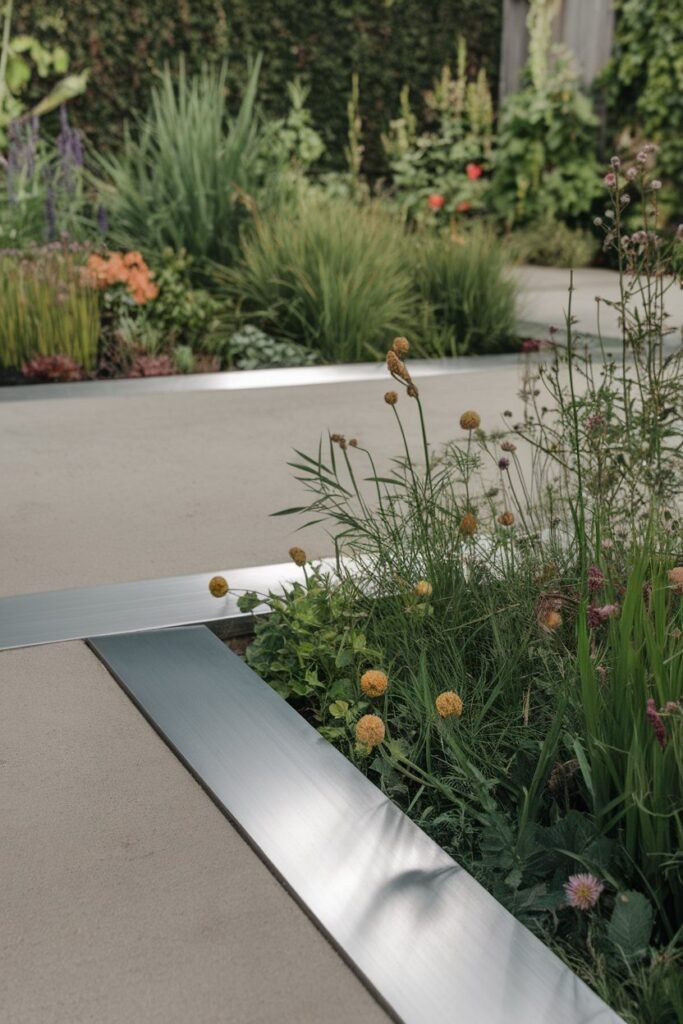
Metal edging is a modern, sleek way to define and shape a walkway. It works well in minimalist or industrial-themed gardens, as it adds a contemporary, clean-line element.
Metal edging can be used to create straight or curved pathways, and it’s durable enough to withstand the elements.
Consider using corten steel for a rusted, weathered look or aluminum for a sleek, polished appearance.
17. Curved Walkway

Curved walkways add elegance and flow to a backyard. A gentle curve can make your garden feel more inviting and create a sense of discovery as visitors meander through the space.
Curved paths work particularly well in large gardens or landscapes that need a more organic feel.
You can use a variety of materials, including stone, brick, or gravel, to create a winding path that enhances the beauty of your garden.
18. Lighted Walkway

A lighted walkway not only adds safety to your path but also creates a magical ambiance at night.
Solar lights, LED strips, or lanterns can be added along the edges of the walkway to illuminate the path. Lighted walkways are especially beautiful in the evening, adding a warm glow to your garden and highlighting the surrounding plants.
This is an excellent choice for enhancing your outdoor space and extending the usability of your backyard after dark.
FAQs
What is the cheapest way to make a walkway?
The cheapest way to make a walkway is by using gravel or mulch. Both materials are affordable, easy to install, and require minimal maintenance. Simply clear the path, lay down landscape fabric to prevent weeds, and spread the gravel or mulch evenly. Adding simple edging like bricks or wood can help keep the material in place while maintaining a neat appearance.
How wide should a backyard walkway be?
A backyard walkway should typically be 3 to 4 feet wide to allow comfortable walking space for one or two people. For smaller garden paths or decorative walkways, 2 feet may be sufficient, while main walkways leading to patios or seating areas may be 4 to 6 feet wide for a more spacious feel.
What is the slope of a walkway?
The slope of a walkway should be 1% to 5% (or 1/8 inch to 5/8 inch per foot) to ensure proper drainage while remaining safe and accessible.
For comfortable walking: Keep the slope under 5% (1:20 gradient) to prevent it from being too steep.
For drainage: A minimum slope of 1% (1/8 inch per foot) helps prevent water pooling.
For ADA compliance: Walkways should not exceed 5% slope unless handrails and landings are provided.
Conclusion:
With these 18 backyard walkway ideas, you have a variety of materials, styles, and designs to choose from to create a path that fits your garden’s unique aesthetic.
Whether you prefer a simple gravel walkway or an intricate mosaic path, there’s something for everyone.
Take the time to explore your options, mix and match materials, and design a walkway that enhances your backyard’s beauty and functionality. Happy gardening!

